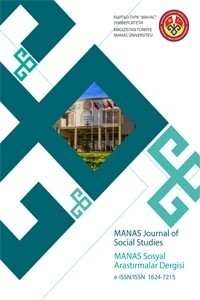Öz
Ahşap tavanlı ve direkli cami
yapma geleneğinin kökeni, Orta Asya Türk mimarisine dayanır. Bu gelenek
Anadolu’da da devam ettirilmiştir. Anadolu’da XIII. Yüzyıldan XIX. Yüzyıla
kadar bu teknikte camiler inşa edilmiştir. XVIII ve XIX. yüzyıllarda ise bu
inşa tekniğinin sıkça uygulandığı ve döneminin üslubunu yansıtan kalemişi
bezemelerle bir arada kullanıldığı görülmektedir.
Bu çalışmanın
konusu olan Amasya’nın Şıhlar ve Kızılkışlacık Köylerindeki ahşap tavanlı iki
cami, XVIII-XIX. yüzyıl mimarisi ve bezemesi hakkında değerli bilgiler
sunmaktadır. Daha önce çalışılmamış olan bu eserler; plan, malzeme ve bezeme
özellikleri bağlamında incelenecektir. Ayrıntılı bir şekilde incelenen
eserlerin, Türk sanatındaki yeri ve önemi ortaya konulmaya çalışılacaktır.
Günümüzde harap durumda olan eserlerin korunması yönünde adımlar atılacaktır.
Anahtar Kelimeler
Kaynakça
- Akok, M. (1946). “Kastamonu’nun Kasaba Köyünde Candarlıoğlu Mahmud Bey Camii”, Belleten, X, 293-302.
- Çal, H. (2000). Niğde Şehrindeki Ahşap Tavanlı Camiler ve Mescidler, Ankara: T.C. Kültür Bakanlığı Yayınevi.
- Deniz, B. (2016). “Aksaray’da (Niğde) Ahşap Sütunlu İki Köy Camii” Sanat Tarihi Dergisi, 4, 19-56.
- Denktaş, M. (2004). “Pınarbaşı-Uzunyayla’daki Ahşap Direkli Camiler”, Erciyes Üniversitesi, Sosyal Bilimler Enstitüsü Dergisi, 16, 53-89.
- Duran, R. (1985). “Konya Sarayönü'nde Üç Ahşap Cami”, Vakıflar Dergisi, XIX, 47-62.
- Karamağaralı, H. (1982). “Sahipata Caminin Restitüsyonu Hakkında Bir Deneme”, Röleve Restorasyon Dergisi, 3, 49-76.
- Koçyiğit Tepe, F. (2017). “Zamana Yenik Düşen Bir Esere Görgü Tanığı Olmak: Amasya Kaleköy Camii”, Karadeniz Araştırmaları, 53, 153-166.
- Kuran, A. (1972). “Anadolu’da Ahşap Sütunlu Selçuklu Mimarisi”, Malazgirt Armağanı, 179-186.
- Tay, L. (2017). “Kırşehir Mucur Camileri”, SDÜ Art-E, Güzel Sanatlar Fakültesi Sanat Dergisi, X, 691-729.
- Uysal, Z. (2014). “18. Yüzyıldan Ahşap Direkli İki Cami”, Turkish Studies, 9, 1107-1123.
- Yavuz, M. (2009). “Doğu Karadeniz Köy Camilerinde Bezeme Anlayışı”, Uluslararası Sosyal Araştırmalar Dergisi, 2/6, 306-322.
The Example of two Mosques with Wooden Ceiling in Amasya: Mosques of The Şihlar and Kizilkıslacik Villages
Öz
The origin of the tradition of making wooden ceilings and pillars is based on the Turkish architecture of Central Asia. This tradition continued also in Anatolia. Mosques were built in this technique from the 13th to the 19th centuries in Anatolia. In the 18th and 19th centuries, it was observed that this construction technique was frequently applied and it is seen that it is used the wall paintings (with a pen-work technique – Kalemişi) that reflect the style of the period. The two mosques with wooden ceilings in Şıhlar and Kızılkışlacık villages of Amasya, which is the subject of this study, provide valuable information about the architecture and ornaments of the 18th-19th century. The buildings that have not been studied before will be examined in the context of their plan, material and the ornament features. It will be tried to reveal the importance in Turkish art of the buildings that examined in detail. It will be taken a step to protect of these buildings that have survived in a dilapidated condition at the present day.
Anahtar Kelimeler
Amasya Mosque Wooden Ceiling Wooden Pillar Wall Painting (pen-work technique – Kalemişi).
Kaynakça
- Akok, M. (1946). “Kastamonu’nun Kasaba Köyünde Candarlıoğlu Mahmud Bey Camii”, Belleten, X, 293-302.
- Çal, H. (2000). Niğde Şehrindeki Ahşap Tavanlı Camiler ve Mescidler, Ankara: T.C. Kültür Bakanlığı Yayınevi.
- Deniz, B. (2016). “Aksaray’da (Niğde) Ahşap Sütunlu İki Köy Camii” Sanat Tarihi Dergisi, 4, 19-56.
- Denktaş, M. (2004). “Pınarbaşı-Uzunyayla’daki Ahşap Direkli Camiler”, Erciyes Üniversitesi, Sosyal Bilimler Enstitüsü Dergisi, 16, 53-89.
- Duran, R. (1985). “Konya Sarayönü'nde Üç Ahşap Cami”, Vakıflar Dergisi, XIX, 47-62.
- Karamağaralı, H. (1982). “Sahipata Caminin Restitüsyonu Hakkında Bir Deneme”, Röleve Restorasyon Dergisi, 3, 49-76.
- Koçyiğit Tepe, F. (2017). “Zamana Yenik Düşen Bir Esere Görgü Tanığı Olmak: Amasya Kaleköy Camii”, Karadeniz Araştırmaları, 53, 153-166.
- Kuran, A. (1972). “Anadolu’da Ahşap Sütunlu Selçuklu Mimarisi”, Malazgirt Armağanı, 179-186.
- Tay, L. (2017). “Kırşehir Mucur Camileri”, SDÜ Art-E, Güzel Sanatlar Fakültesi Sanat Dergisi, X, 691-729.
- Uysal, Z. (2014). “18. Yüzyıldan Ahşap Direkli İki Cami”, Turkish Studies, 9, 1107-1123.
- Yavuz, M. (2009). “Doğu Karadeniz Köy Camilerinde Bezeme Anlayışı”, Uluslararası Sosyal Araştırmalar Dergisi, 2/6, 306-322.
Ayrıntılar
| Birincil Dil | Türkçe |
|---|---|
| Bölüm | Araştırma Makalesi |
| Yazarlar | |
| Yayımlanma Tarihi | 27 Nisan 2019 |
| Gönderilme Tarihi | 4 Şubat 2019 |
| Yayımlandığı Sayı | Yıl 2019 Cilt: 8 Sayı: 2 |
Kaynak Göster
Cited By
MANAS Journal of Social Studies (MANAS Sosyal Araştırmalar Dergisi)

